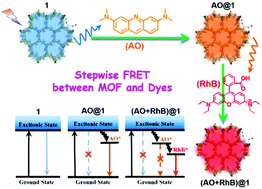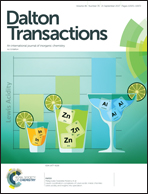Diverse dissolution–recrystallization structural transformations and sequential Förster resonance energy transfer behavior of a luminescent porous Cd-MOF†
Abstract
Metal–organic frameworks (MOFs) with light-harvesting building blocks provide an excellent platform to study energy transfer in networks with well-defined structures. Here, we report the synthesis, dissolution–recrystallization structural transformation (DRST) and the Förster resonance energy transfer (FRET) properties of a 2D microporous MOF {[Cd2(L1)3(Hdabco)2]·5DMAc·6H2O}n (Cd-MOF, 1). Complex 1 can be dissolved in water and three other products with different dimensions recrystallized from the aqueous solution under diverse reaction conditions were obtained. Due to the porosity and excellent blue luminescence properties of complex 1, we also studied the FRET process between 1 and guest dyes. Two distinct organic dye molecules viz., acridine orange (AO) and rhodamine B (RhB), are encapsulated in 1 which has honeycomb-type nanochannels, and their influence on fluorescence emission has also been studied. The microporous complex 1 in (AO + RhB)@1 serves as an energy funnel that harvests high energy excitation and channels it onto AO and then onto RhB. The steady-state fluorescence and fluorescence dynamics of emission reveal successfully the process of stepwise vectorial energy transfer. Therefore, MOFs could be a class of promising host materials to be further explored in the field of energy transfer between MOF-host and organic guests.



 Please wait while we load your content...
Please wait while we load your content...